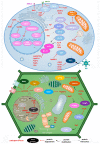Ubiquitin-Dependent and Independent Proteasomal Degradation in Host-Pathogen Interactions
- PMID: 37764516
- PMCID: PMC10536765
- DOI: 10.3390/molecules28186740
Ubiquitin-Dependent and Independent Proteasomal Degradation in Host-Pathogen Interactions
Abstract
Ubiquitin, a small protein, is well known for tagging target proteins through a cascade of enzymatic reactions that lead to protein degradation. The ubiquitin tag, apart from its signaling role, is paramount in destabilizing the modified protein. Here, we explore the complex role of ubiquitin-mediated protein destabilization in the intricate proteolysis process by the 26S proteasome. In addition, the significance of the so-called ubiquitin-independent pathway and the role of the 20S proteasome are considered. Next, we discuss the ubiquitin-proteasome system's interplay with pathogenic microorganisms and how the microorganisms manipulate this system to establish infection by a range of elaborate pathways to evade or counteract host responses. Finally, we focus on the mechanisms that rely either on (i) hijacking the host and on delivering pathogenic E3 ligases and deubiquitinases that promote the degradation of host proteins, or (ii) counteracting host responses through the stabilization of pathogenic effector proteins.
Keywords: 20S proteasome; 26S proteasome; E3 ligases; UPS; deubiquitinases; host–pathogen interactions; protein degradation; ubiquitin.
Conflict of interest statement
The authors declare no conflict of interest.
Figures
Similar articles
-
Regulating the 20S proteasome ubiquitin-independent degradation pathway.Biomolecules. 2014 Sep 23;4(3):862-84. doi: 10.3390/biom4030862. Biomolecules. 2014. PMID: 25250704 Free PMC article. Review.
-
Ubiquitin proteasome system in immune regulation and therapeutics.Curr Opin Pharmacol. 2022 Dec;67:102310. doi: 10.1016/j.coph.2022.102310. Epub 2022 Oct 23. Curr Opin Pharmacol. 2022. PMID: 36288660 Free PMC article. Review.
-
Modulation of Ubiquitin Signaling in Innate Immune Response by Herpesviruses.Int J Mol Sci. 2022 Jan 1;23(1):492. doi: 10.3390/ijms23010492. Int J Mol Sci. 2022. PMID: 35008917 Free PMC article. Review.
-
Bacterial effectors mimicking ubiquitin-proteasome pathway tweak plant immunity.Microbiol Res. 2021 Sep;250:126810. doi: 10.1016/j.micres.2021.126810. Epub 2021 Jun 30. Microbiol Res. 2021. PMID: 34246833 Free PMC article. Review.
-
Assaying proteasomal degradation in a cell-free system in plants.J Vis Exp. 2014 Mar 26;(85):51293. doi: 10.3791/51293. J Vis Exp. 2014. PMID: 24747194 Free PMC article.
Cited by
-
Occupancy of the HbYX hydrophobic pocket is sufficient to induce gate opening in the archaeal 20S proteasomes.bioRxiv [Preprint]. 2025 May 29:2024.05.21.595185. doi: 10.1101/2024.05.21.595185. bioRxiv. 2025. Update in: Elife. 2025 Aug 14;14:RP106611. doi: 10.7554/eLife.106611. PMID: 38826226 Free PMC article. Updated. Preprint.
-
HSV-1 UL56 protein recruits cellular NEDD4-family ubiquitin ligases to suppress CD1d expression and NKT cell function.J Virol. 2025 Apr 15;99(4):e0214024. doi: 10.1128/jvi.02140-24. Epub 2025 Mar 6. J Virol. 2025. PMID: 40047437 Free PMC article.
-
Homeobox protein MSX-1 restricts hepatitis B virus by promoting ubiquitin-independent proteasomal degradation of HBx protein.PLoS Pathog. 2025 Jan 30;21(1):e1012897. doi: 10.1371/journal.ppat.1012897. eCollection 2025 Jan. PLoS Pathog. 2025. PMID: 39883729 Free PMC article.
-
Saccharomyces cerevisiae as a Model for Studying Human Neurodegenerative Disorders: Viral Capsid Protein Expression.Int J Mol Sci. 2023 Dec 7;24(24):17213. doi: 10.3390/ijms242417213. Int J Mol Sci. 2023. PMID: 38139041 Free PMC article. Review.
-
RNF144A inhibits autophagy by targeting BECN1 for degradation during L. monocytogenes infection.Autophagy. 2025 Apr;21(4):789-806. doi: 10.1080/15548627.2024.2429380. Epub 2024 Nov 28. Autophagy. 2025. PMID: 39608349
References
Publication types
LinkOut - more resources
Full Text Sources


